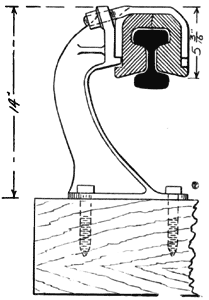[Trade Journal]
Publication: Electrical Age
New York, NY, United States
vol. 36, no. 4, p. 261, col. 1-3
Electrical Equipment of the West Shore Railroad
SOME particulars of the electrical equipment of the West Shore Railroad are given in a recent issue of "The Railway Age." The section of the road undergoing electrification is that part between the city limits of Syracuse and the crossing of the railroad and Genesee street in Utica. This distance is 44 miles. The distance from the centre of Utica and the centre of Syracuse is 48.6 miles. The passenger schedule provides for limited trains in each direction leaving on the even hours and making the distance from downtown terminal to downtown terminal in i hour and 22 minutes, and trains each way leaving on the half-hour, making the run in 1 hour and 52 minutes, this latter service caring for local traffic.
The passenger schedule contemplated, taken in connection with the freight traffic which the West Shore would handle with steam-operated trains, required that one or two additional tracks be built over certain sections of the line. These additional tracks will enable the passenger trains operated by electricity at 55 and 45 miles per hour, respectively, to avoid interference with the freight trains operated by steam, which are of two classes, fast freights with a schedule of about 25 miles per hour and local freights with a schedule of about 15 miles per hour.
For the purpose of construction the line has been made into four sub-divisions, as follows:—
Genesee street, in Utica, to Vernon grade, 11.3 miles long, with a total of 31 miles of track.
Vernon grade to Lenox avenue, Oneida, 10 miles long, with 24.5 miles of track.
Lenox avenue, Oneida, to Chittenango, 10.3 miles long, with 26.6 miles of track.
Chittcnango to Syracuse city limits, 12.5 miles long, with 25.6 miles of track.
Work was started on May 15, and the installation of the third rail is practically complete on the first section. Third-rail ties are in place and rails distributed in the second section, and work on the third section was begun on August 1. The electrical equipment is being done by the Oneida Railway Company, of Oneida, a corporation organized under the earlier railroad laws and having a more liberal charter than could be obtained were a new corporation to be organized at this time.
 |
| Third Rail in Use on the Electrified Section of the West Shore Railroad |
The Oneida Railway Company has contracted with the Hudson River Electric Power Company for the delivery of three-phase current at a potential of 60,000 volts at the Oneida Railway Company's sub-station at Clarks Mills, about seven miles west of Utica. The Hudson River Electric Power Company will, for the present, generate this current at its auxiliary steam plant in Utica. Upon the completion of its transmission lines, current will undoubtedly be taken later from hydro-electric plants owned by this company in the eastern part of the State.
The Oneida Railway Company is building four sub-stations located about 10 ½ miles apart. These, counting west from Utica, are located at Clarks Mills, at a point 1 ½ miles west of Vernon, at a point 2 ½ miles west of Canastota, and at Manlius Centre, which is 5 ½ miles east of Syracuse city limits. These sub-stations will be identical in construction, and each will be equipped with two 300-kilowatt rotary converters and the necessary equipment for transforming 60,000-volt, three-phase current to direct current for distribution to the rail at 600 volts.
The transmission line connecting the company's sub-stations will be of No. 0 stranded copper cable supported on narrow base steel towers. There are to be 391 of these towers, with a normal spacing of 480 feet, the great majority of them being 39 feet high; the highest are 63 feet, measuring from the top of the foundation to the bottom insulators. The insulators are of the four-petticoat type, 13 1/2 inches high over all and 14 inches maximum diameter. The three conductors will be at the vertices of an equilateral triangle 7 feet on a side.
The third-rail construction is the Wilgus underrunning protected type, which is the standard adopted by the New York Central. The rail is a double-headed section, 4 3-16 inches high and 2 9-16 inches wide, weighing 70 pounds to the yard. The rail protection adopted is of two types. For all but 10 miles the protection is of yellow pine designed to give at least 1 1/4 inches of wood above the rail and on both sides. On ten miles of the third rail the protection is of fibre 3-16 inches thick moulded to conform to the outline of the rail section and sufficiently flexible to permit lengths of this 'to be slipped over the top head of the rail.
